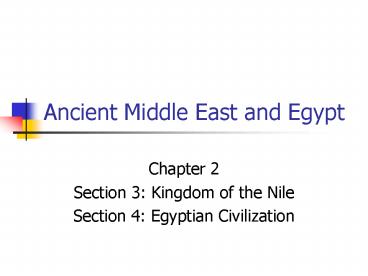Ancient Middle East and Egypt - PowerPoint PPT Presentation
1 / 11
Title:
Ancient Middle East and Egypt
Description:
Egyptians relied on the floods for water and silt. They also had to cooperate in order to channel and ... Egyptians mastered the Hyksos horse-drawn chariot. ... – PowerPoint PPT presentation
Number of Views:35
Avg rating:3.0/5.0
Title: Ancient Middle East and Egypt
1
Ancient Middle East and Egypt
- Chapter 2
- Section 3 Kingdom of the Nile
- Section 4 Egyptian Civilization
2
Kingdom of the Nile
Map Skills (pg. 31)
- How did the yearly floods of the Nile influence
life in ancient Egypt? - Egyptians relied on the floods for water and
silt. They also had to cooperate in order to
channel and store the water. They built dykes,
reservoirs and irrigation ditches.
Satellite photo of the Nile River delta.
3
Kingdom of the Nile
Worlds longest river
- A cataract is a waterfall.
- The Nile extends another 3,600 miles south of its
first cataract. - Other civilizations may have risen along the Nile
because of its fertile soil and usefulness as a
trade route.
4
City-States of Ancient Sumer
Middle and New Kingdoms
Turbulent Middle Kingdom Describe the cultural
diffusion that occurred between the Middle
Kingdom and foreign invaders. About 1700 the
Hyksos occupied Egypt. Egyptians mastered the
Hyksos horse-drawn chariot. The Hyksos adopted
Egyptian customs, beliefs and even names.
Who were the notable Pharaohs during the New
Kingdom? Hatshepsut, Thutmose III and Ramses II.
What role did conquest of others play during
Egypts New Kingdom? Conquest was central to the
expansion of the New Kingdom. Pharaohs expanded
Egypt as they conquered lands to the North and
South.
5
Kingdom of the NIle
Biography
- Why do you think Hatshepsut wanted to leave a
record of her accomplishments? - She may have wanted to leave a reminder of her
greatness, and the fact that she was a woman.
6
Egyptian Civilization
Review Questions
- Amon-Re was the greatest of gods. People revered
his power. Rulers received their right to rule
from him.
What details about the Egyptian gods show the
importance of agriculture to Egyptian society?
The most important gods were associated with the
sun and the Nil, both of which were associated
with agriculture.
7
Egyptian Civilization
Religion
- Since Egyptians believed that their Pharaohs
received the right to rule from Amon-Re. How do
you think replacing him with the god Aton would
have affected the authority of the Pharaohs? - The Pharaohs would have had to find some other
way to establish their authority or the people
would no longer believe in them as devine.
8
Egyptian Civilization
Infographic
- Mummification tells us that it was important for
Egyptians to carefully preserve the body for use
in the afterlife. - Mummification help Egyptians learn about biology,
chemistry, physiology.
- Tutankhamen was a minor king, but, his tomb was
untouched for 3.000 years. This provided
scholars with a wealth of information about
Egyptian civilization. (what must a tomb for a
great Pharaoh been like.)
9
Egyptian Civilization
Egyptian Society
- Which social class grew in size as a result of
trade and warfare? - The social class that included merchants and
artisans grew as trade and warfare increased.
10
Egyptian Civilization
Rosetta Stone
- How did the Rosetta stone help scientists
decipher the meaning of ancient hieroglyphics? - This flat black stone presents the same passage
carved in hieroglyphics, demotic script and
Greek. From this scientists were able to figure
out the meaning of many hieroglyphics.
11
Egyptian Civilization
Arts Literature
- What forms of art and literature were common in
ancient Egypt? - statues, paintings, sculpture and architecture
were common in ancient Egypt.































